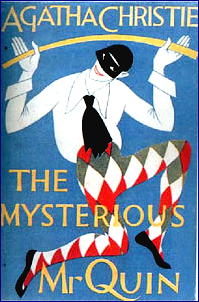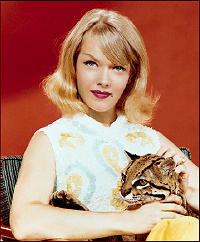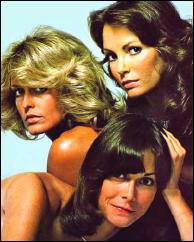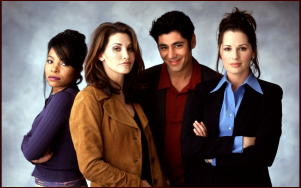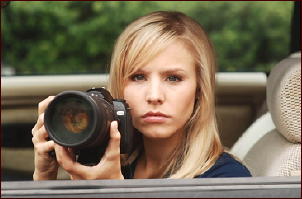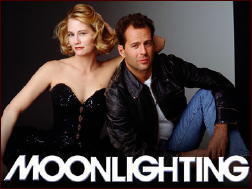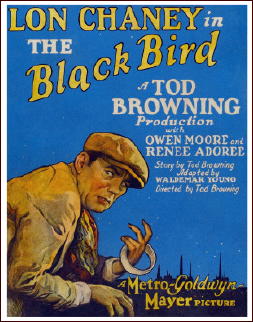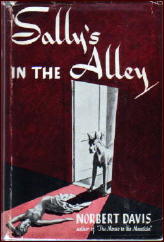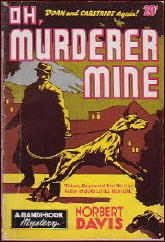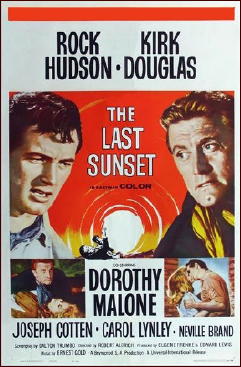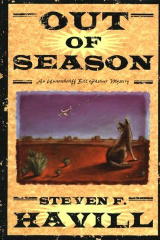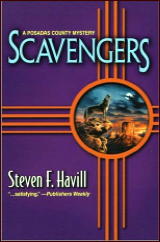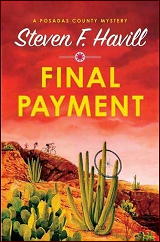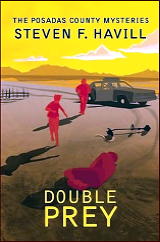March 2012
Monthly Archive
Tue 13 Mar 2012
Posted by Steve under
Reviews[3] Comments
IT IS PURELY MY OPINION
Reviews by L. J. Roberts
AGATHA CHRISTIE – The Mysterious Mr. Quin. Collins, UK, hardcover, 1930. Dodd Mead, US, hardcover, 1930. Reprinted many times in paperback. Note that the Bestseller paperback, 1940, omits three stories. Film (from the short story “The Coming of Mr. Quinâ€): Strand, 1928, as The Passing of Mr. Quin.
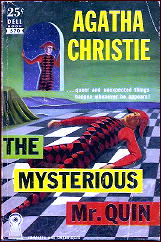
Mr. Satterthwaite, although 62 years old, is described as a dried-up man. (Views on age have changed over time.) He is wealthy, loves the good things in life, definitively British and is a keen observer of people. The last attribute increases with each encounter with Mr. Harley Quin.
Mr. Quin is a gentleman of mystery: Is he real with supernatural powers, or Ms. Christie’s very own, and very different version of Holmes? Quinn was, in fact, Ms. Christie’s favorite character. In her autobiography, she describes him as “a friend of lovers and connected with death.â€
She does allude to the classic Harlequin in “The Soul of the Croupier†when Satterthwaite expresses surprise seeing Quin. Quin responds “It should not surprise you,†he said. “It is Carnival time. I am often here in Carnival time.â€
In general, I’m not a fan of short stories, but I find myself frequently re-reading these. I do love Satterthwaite’s line of “I can put up with vulgarity, but I can’t stand meanness.†The stories have a slight supernatural quality to them, but always with a logical explanation possible, and certainly to the solutions of the crimes.
I enjoyed Christie’s perception of 1930s England as being multi-cultural and non-denominational, but wonder who true that was. What I most enjoy, however, is that each story stands alone and is intriguing and compelling on its own merit.
Rating: Excellent.
Mon 12 Mar 2012
MAKE A LIST:
American TV Series with Female Licensed PI’s
by Michael Shonk
This is a list of the female licensed PI’s featured in American TV series only. We will save the amateurs such as Murder She Wrote ’s Jessica Fletcher, female spies such as Mrs. Smith in Mr. & Mrs. Smith, and female cops such as Samantha Spade in Without a Trace for other lists.
THE LIST:
HONEY WEST (ABC 1965-1966). Based on a series of books by G.G. Fickling (Gloria and Forrest Fickling), the series starred Anne Francis as licensed PI Honey West. Honey West’s first television appearance was in Burke’s Law episode “Who Killed the Jackpot†(April 21, 1965).
MOST DEADLY GAME (ABC, 1970-1971) Yvette Mimieux played Vanessa Smith, one of three criminologists who worked together solving unusual murders.
CHARLIE’S ANGELS (ABC, 1976-1981) Charlie’s “angels†were female PIs Sabrina Duncan (Kate Jackson), Jill Munroe (Farah Fawcett), Kelly Garrett (Jaclyn Smith), Kris Munroe (Cheryl Ladd), Tiffany Welles (Shelley Hack), and Julie Rogers (Tanya Roberts).
REMINGTON STEELE (NBC, 1982-1987) PI Laura Holt (Stephanie Zimbalist) created a fictional male boss for her agency to attract clients who thought the idea of a female PI was too feminine. Then one day he walked in…
TUCKER’S WITCH (CBS, 1982-1983) Catherine Hicks as Mrs. Amanda Turker. PI and witch. See: https://mysteryfile.com/blog/?p=6805
PARTNERS IN CRIME (NBC, 1984) PI Raymond Caulfield left his agency to his ex-wives, proper brunette Carole Stanwyck (Lynda Carter) and fun loving blonde Sydney Kovak (Loni Anderson).
ME AND MOM (ABC, 1985) PI Kate Morgan (Lisa Eilbacher) solved crimes with her mom’s (Holland Taylor) help.
LEG WORK (CBS, 1987) Margaret Colin as former assistant district attorney turned PI Claire McCarron, who liked to live beyond her means in New York.
DIAMONDS (CBS Lste Night, 1987-1988) Married couple Christina Towne (Peggy Smithhart) and Mike Devitt (Nicholas Campbell) played PIs on a TV series. The series got cancelled and they got divorced. Later they decided to start their own PI agency.
SYDNEY (CBS, 1990) Sitcom starring Valerie Bertinelli as PI Sydney Kells.
BAYWATCH NIGHTS (Syndicated, 1995-1997) Ryan McBride (Angie Harmon) and Mitch Buchannon (David Hasselhoff) leave the beach to become PIs.
SNOOPS (ABC, 1999) PI agency owned by PI Glenn Hall (Gina Gershon). The staff featured Dana Plant (Paula Marshall), Roberta Young (Paula Jai Parker) and token guy Manny (Danny Nucci).
WILD CARD (Lifetime, 2003-2005) Zoe Busiek (Joey Fisher) teamed up with Dan Lennox (Chris Potter) as PIs for an insurance company. Rae Dawn Chong played PI Sophia Mason in the first season.
VERONICA MARS (UPN 2004-2006) (CW, 2006-2007) Veronica (Kristen Bell) was a student and part time PI in her father’s PI agency.
SEX DECOY (Fox Reality, 2009) Reality series with PI Sandra Hope. She and her operatives entrap cheating husbands for our viewing pleasure.
THE GOOD WIFE (CBS, 2009–present). Law drama. PI Kalinda Sharma (Archie Panjab) works for the law firm Lockhart Gardner.
CHARLIE’S ANGELS (ABC, 2011) Remake with new “angels,†Kate Prince (Annie Ilonzeh), Eve French (Minka Kelly), and Abby Sampson (Rachael Taylor).
PI or Not PI:
KHAN (CBS, 1975) PI Khan (Khigh Dhiegh) was helped by his two college aged children, a son, and his criminologist student daughter Anna (Irene Yah-Ling Sun).
MOONLIGHTING (ABC, 1985-1989) Model Maddie Hayes (Cybill Shepherd) was horrified to discover she owned the Blue Moon detective agency. The agency employed one PI, David Addison (Bruce Willis). David and Maddie solved crimes and found ways to drive up each other’s blood pressure.
EYE TO EYE (ABC, 1985) PI Oscar Poole (Charles Durning) teams up with ex-partner’s young sexy daughter, Tracy Doyle (Stephanie Faracy).
TOTAL SECURITY (ABC, 1997) High-tech security firm with large staff including Jody Kiplinger (Debrah Farentino) and Ellie Jones (Tracey Needham).
V.I.P. (Syndicated, 1998-2002) Pamela Anderson plays Vallery Irons, the “Remington Steele†of bodyguards. While the public believes Vallery is the world’s greatest bodyguard, it is her staff that does all the work. The staff included ex-spy Tasha Dexter (Molly Culver), Nikki (Natalie Raitano) weapons expert, Kay (Leah Lail) computer expert, and Quick (Shaun Baker) marksman and ex-boxer.
THE HUNTRESS (USA, 2000-2001) Dorothy “Dottie†Thorson (Annette O’Toole) and her daughter, Brandi (Jordana Spiro) ran a bounty hunting business.
EYES (ABC, 2005) Harlan Judd (Tim Daly) ran a high-tech investigation firm. The female members of the staff included Nora Gage (Garcelle Beauvais), Meg Bardo (A.J. Langer), Leslie Town (Laura Leighton), and Trish Agermeyer (Natalie Zea).
Did I miss anyone?
I recommend the Thrilling Detective website as a good place to look, especially this page: https://www.thrillingdetective.com/tveyes.html
Other sources include the usual “suspectsâ€: IMDB.com, TV.com, and Complete Directory to Prime Time Network and Cable TV Shows, 1946-Present, by Tim Brooks and Earle Marsh (Ballantine, Ninth edition).
Mon 12 Mar 2012
THE ARMCHAIR REVIEWER
Allen J. Hubin
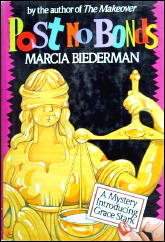
MARCIA BIEDERMAN – Post No Bonds. Scribner’s, hardcover, 1988. Penguin, paperback, 1989.
Marcia Biederman makes her second excursion into our precincts with Post No Bonds. Phil Stark is a bail bondsman in Massachusetts. His wife Grace wants to redo the house, but Phil’s business is not flourishing. Grace’s attempts to improve Phil’s competitive position bring the law down around his neck, so he transfers the business and assets to Grace and tries selling insurance.
Grace is a no-nonsense, middle-aged type, fully capable of larceny and pulling triggers in a good cause. The good cause shortly presents itself: she bails a drug dealer, who skips, leaving Grace holding a $30,000 bag. Attaching herself to Darcy, the dealer’s market analyst cum bedmate, Grace sets out to get her investment back. An amusing and inventive tale.
— Reprinted from The MYSTERY FANcier,
Vol. 11, No. 1, Winter 1989.
Bibliographic Data: For some reason I thought Grace Stark was a recurring character, but not so. [Footnote.] Marcia Biederman wrote only three novels before leaving the field of crime fiction:
The Makeover. Academy Chicago, 1984.
Post No Bonds. Scribner, 1988.
Sismo. Walker, 1993.
One other online review of Post No Bonds is very positive, saying in part: “Pledging her condominium as collateral for Heywood’s bond is his girlfriend Darcy, who also teams with Grace to bring in Heywood. They make an effective, unorthodox pair of amateur sleuths. […] The incongruity of finding a housewife such as Grace Stark in such places gives the book much of its humor. Armed with a pistol and a bulletproof raincoat, Grace proves to be surprisingly resourceful and tough enough to hold her own. Added fun comes from the interplay between the incompatible Grace and Darcy.”
Makes one wish that there was another book telling of their adventures.
[Footnote.] Now I remember. The cover of the hardcover edition states: “A Mystery Introducing Grace Stark.”
Sun 11 Mar 2012
REVIEWED BY WALTER ALBERT:
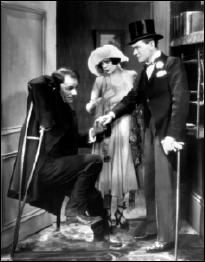
THE BLACKBIRD. MGM, 1926. Lon Chaney, Renée Adorée, Owen Moore, Doris Lloyd. Director: Tod Browning. Shown at Cinevent 35, Columbus OH, May 2003.
I had seen this film a few years ago, but the Chaney-Browning combination is always a pleasure to revisit. Chaney plays two brothers, one a crippled preacher (The Bishop) who succors the wayward inhabitants of Limehouse, the other a criminal mastermind (the Blackbird), who is the antithesis of the saintly Bishop.
Chaney’s masterful dual portrayals are well supported by Moore, Adorée and Lloyd, in a complex of relationships that complement Chaney’s Jekyll/Hyde roles. The beginning is particularly striking as it displays a series of close-ups of Limehouse characters, immediately establishing the grotesque strain that is developed in Chaney’s characterizations.
Editorial Comment: Shown in the photo image above are the three stars of the film, Lon Chaney, Renée Adorée, and Owen Moore. The movie has been shown on TCM; whether recently, I do not know.
Sun 11 Mar 2012
Posted by Steve under
Reviews[11] Comments
THE BACKWARD REVIEWER
William F. Deeck
MARCH EVERMAY – They Talked of Poison. Macmillan, US, hardcover, June 1938.
On Wednesday nights during the academic season, Harry Curry, professor of sociology at Penfield University, delivers his criminology lectures at his home. Afterwards, Curry’s wife serves refreshments, of which the family dog usually partakes. After one session the dog dies suddenly, possibly the victim of poison. Later that night one of the attendees, the Rev. Dr. Perley, is found dead in his car in Curry’s garage; his death, however, is deemed natural.
Perley’s daughter has made a bad marriage to a writer of awful — in the literary sense — semipornography, in unthinking reaction after Perley had told her she could not marry a divorced doctor. Shortly after her father’s death, she commits suicide. Or so it seems until Curry’s niece, who is the narrator here but appears to have no personality, spots an anomaly.
This is a very complex and leisurely case, with interesting characters, especially the clergyman’s wife, who fears what the congregation will think and may have murdered both her husband and her daughter for that reason. For nearly fifty pages the police detective explains who didn’t do it before he reveals who did do it, but the time is well spent by the reader who wants his or her money’s worth.
— From The MYSTERY FANcier, Vol. 11, No. 1, Winter 1989.
BIO-BIBLIOGRAPHIC DATA —
According to Hubin, March Evermay was the pen name of Mathilde Eiker, 1893-1982. She wrote one other work of detection fiction, This Death Was Murder (Macmillan, 1940), also with Inspector Glover, whom Bill seems not to have mentioned by name.
A one-line summary of the Kirkus review of this book: “Baltimore is the setting for the detailed unravelling of crimes solved more satisfactorily for the group than for the reader.” The one in Saturday Review is more favorable: “Almost unguessable riddle…”
The bad news is that here is, when last I looked, about five minutes ago, only one copy of this book offered for sale online. You can find it on Amazon from a third party seller for a mere $325.
Fri 9 Mar 2012
[When you think of Old-Time Radio, what program is the first that comes to mind? I’ll bet most people, at least those over a certain age, will say one of the following: The Lone Ranger, The Shadow, or even The Jack Benny Program.] To some minds old radio has become nearly synonymous with top-notch horror shows, and Lights Out has a reputation in this regard second to none.
I happen to think that the series as a whole is largely overrated, but then again there were a few prime examples of creepy crawly midnight chills on that series, real chillers that stay longer in the memory than those of other similar shows, and somehow they seem to make up for all the dull rather uninspired episodes that everyone manages to forget.
The theme of “Superfeature” the show broadcast on April 6, 1943, is a good one. According to Arch Oboler’s introduction, the most frightening thing in the world is the everyday object suddenly no longer seen or heard in its commonplace form. The familiar unfamiliar. The shutter banging in the wind. The cat at night staring at you with suddenly gleaming eyes.
Even motion picture projectors. You don’t get to see the show that the two backwoods entrepreneurs put on to bring the spice of life to audiences of country bumpkins, with ulterior motives, but you can certainly imagine it from the reactions of the crowd. The finale of their repertoire is a monster flick, that mysteriously comes to life, later, after the projector has been turned off. And what we learn then is how this pair of crooks finally get what’s coming to them.
It ends with a scary manhunt through a swamp — scary, that is, if your imagination is capable of believing the huge dose of hokum that’s the whole basis of author Arch Oboler’s story.
So … why did I leave the lights on? I’d have to admit that listening to a man drown before my ears is something that could keep a more sensitive person awake for a good long while afterward. You could build quite a reputation for a show based on the sound effects alone.
And only incidentally, I’m also glad to say that I’ve finally discovered what Ironized Yeast was used for.
— Reprinted from The Poisoned Pen, Vol. 2, No. 6, November-December 1979 (slightly revised).
Editorial Comment: Follow the link above to listen to this particular episode yourself. A complete log for Lights Out can be found here.
Thu 8 Mar 2012
NORBERT DAVIS – The Mouse in the Mountain. William Morrow, hardcover, 1943. Handi-Books #40, paperback, 1945, as Dead Little Rich Girl. Rue Morgue Press, trade paperback, 2001.
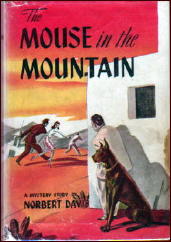
Norbert Davis was a mystery writer who entered the scene in the early 30s with a story in Black Mask magazine entitled “Reform Racket†(June 1932). He managed to switch to the slicks such as Collier’s and The Saturday Evening Post, had a couple of detective novels published in hardcover, then one in paperback, and suddenly the bottom seemed to have fell out of the market for him. He committed suicide in 1949 when he was only 40 years old.
This is the first of the three novels, all featuring the detective “team” of Doan and Carstairs. Doan is a little mild fat man who is also a private eye. According to his description on page 3: “He looked like a very nice, pleasant sort of person, and on rare occasions he was.” Carstairs, his friend and constant companion, is an enormous Great Dane.
Doan and Carstairs are in Mexico in this one, on a mission consisting (according to common knowledge) of finding and convincing a fugitive from the United States to stay in Mexico and not come home to bother a certain group of politicians who would rather certain activities remain unknown.
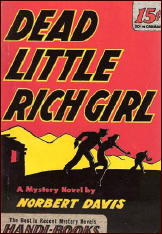
“Common knowledge” may or may not be correct, as I’m sure you realize, and therein likes the story. What is most remarkable about Norbert Davis and his style of writing is how funny the story is, and how quickly the comedy can change into sudden violence.
To reach the village of Los Altos, for example, Doan must take a sightseeing bus loaded with other typical American tourists, including the rich heiress to a flypaper company and a family with one of the brattiest kids this side of the comic strips. The laughter stops, however, at least momentarily, when they arrive and within minutes Doan must shoot an escaped fugitive in the mouth. Within days many more funny incidents have occurred, and so have several more deaths (not including the earthquake).
It’s a top notch job of writing. Even though the plot itself is a little thin, it’s hard to complain about that. Davis makes writing seem so easy that anyone could do it, but if that were so, why can’t everybody write a novel that goes down as smoothly as this?
— Reprinted from The MYSTERY FANcier, Vol. 1, No. 5, September 1977 (slightly revised).
The Doan & Carstairs series —
The Mouse in the Mountain. Morrow, hc, 1943.
Sally’s in the Alley. Morrow, hc, 1943.
Oh, Murderer Mine. Handi-Books, pb, 1946.
A long article about Norbert Davis and one of his enthusiastic readers, philosopher Ludwig Wittgenstein, appears here on the main Mystery*File website. Following the article are several home photos of Davis and a complete bibliography, including his short fiction.
Wed 7 Mar 2012
REVIEWED BY DAN STUMPF:
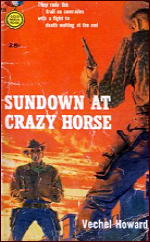
THE LAST SUNSET. Universal Pictures, 1961. Rock Hudson, Kirk Douglas, Dorothy Malone, Joseph Cotten, Carol Lynley, Neville Brand, Regis Toomey, Jack Elam. Screenplay by Dalton Trumbo, based on the book Sundown at Crazy Horse, by Howard Rigsby. Director: Robert Aldrich.
If you’re ever looking for something terse and violent in a Western, you may find it in Sundown at Crazy Horse (1957), by Vechel Howard (aka Howard Rigsby). Like most Gold Medals, it’s a fast, fun read, and Howard has a gift for conveying information with intriguing detail that notches this way above average.
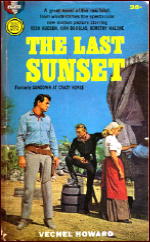
He knows the gritty details of moving cows around, and he can put them across without getting his foot tangled in the stirrup. He also shows a subtle gift for characterization that eludes many more successful writers — insert names here.
In 1961 screenwriter, Dalton Trumbo added a layer of Greek Tragedy to this simple tale, and Robert Aldrich filmed it as The Last Sunset, with Rock Hudson as the lawman, Kirk Douglas the good/bad guy, Dorothy Malone the woman they both want, plus Jack Elam and Neville Brand as a pair of perfectly-cast owlhoots.
They should have known better than to complicate a story whose chief asset was simplicity, as the movie slows up some, but it’s sustained by Aldrich’s flair for the perverse and westerns don’t get much kinkier than this.
Wed 7 Mar 2012
STEVEN F. HAVILL – Heartshot. St. Martin’s Press, hardcover, March 1991. Poisoned Pen Press, softcover, 2007.
There’s always a small shiver of excitement that runs through a reader when a new writer comes along showing all the signs of being a natural-born storyteller. It’s a chancy thing, though, and while it was there at the beginning of Steven Havill’s debut novel Heartbeat, but by book’s end, sadly to say, the flame had flickered and was sadly diminished.
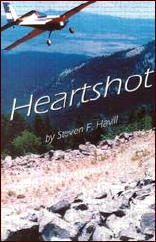
Telling the story is Bill Gastner, an aging (and badly overweight) undersheriff for Posadas County, New Mexico. A relic of the past and chafing under the recent election of a PR-oriented sheriff, Gastner wonders if perhaps his days on the job are numbered. Then a carload of teenagers smashes up, leaving five of them dead, and in the car is $150,000 worth of cocaine.
So Gastner, with the help of Estelle Reyes, the only detective on the force, gets a chance to show he’s still worth his keep. It’s an excellent start, but halfway through the book, things begin to go awry. A fine new secondary character is introduced, but the potential to do even better things with him is sadly wasted.
Maybe Havill didn’t intend to write a mystery. Maybe he meant only to write a crime story taking place in small town near the Mexican border. But if you wish for matters like motives, opportunities and small clues to be connected up, you will have to wait longer than the author seems to have taken pages to tell.
[WARNING: Plot Alert] It might have been a good idea at the time, but one thing I don’t understand is why Gastner contronts one of the villains while they are alone together in a private airplane. (I won’t reveal any identities, but any detective story reader who doesn’t know who it is long before they take off simply hasn’t been paying attention.) Not only that, Gastner has just stolen his way out of a hospital room afer suffering a severe heart attack, and the plane is not pressurized. Oh, oh.
Don’t get me wrong. The characters in Heartshot are terrific. It’s going to be the first in a series, I’m sure, and the people in this one are worth coming back to, to find out more about them. The writing is fine, and the storytelling ability is there. So what’s missing? Simply somebody (an editor, most preferably) to tell the author that the story he’s telling just isn’t holding all the water it’s supposed to.
— Reprinted from Mystery*File 31,
May 1991 (slightly revised).
The Bill Gastner series —
Heartshot (1991)
Bitter Recoil (1992)
Twice Buried (1994)
Before She Dies (1996)
Privileged to Kill (1997)
Prolonged Exposure (1998)
Out of Season (1999)
Dead Weight (2000)
Bag Limit (2001)
After Bill Gastner’s retirement, the remaining books in the series feature Undersheriff Estella Reyes-Guzman:
Scavengers (2002)
A Discount for Death (2003)
Convenient Disposal (2004)
Statute of Limitations (2006)
Final Payment (2007)
The Fourth Time is Murder (2008)
Red, Green, or Murder (2009)
Double Prey (2011)
One Perfect Shot (2012)
[UPDATE] 03-07-12. With all of the followup books in the series, it’s a good thing that Steven Havill did not read this review and decide to call it quits on a writing career, right then and there. Maybe you shouldn’t pay any attention to it, either. In any case, I don’t have any of the other books in the series, and I think I ought to remedy that.
Tue 6 Mar 2012
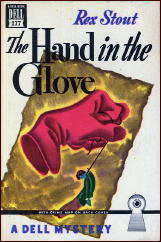
LADY AGAINST THE ODDS. Made-for-TV movie, NBC, 20 April 1992. Crystal Bernard (Dol Bonner), Annabeth Gish, Rob Estes, Kevin Kilner, John Finn, Dan Castellaneta, Heather McAdam, Steven Flynn, Roy Thinnes, Polly Bergen, Barbara Luna. Based on the novel The Hand in the Glove, by Rex Stout. Director: Bradford May.
The Hand in the Glove is one of the small handful of mysteries written by Rex Stout that did not include Nero Wolfe as a character, and I have to admit that I’ve never read it, perhaps for that very same reason. In fact there’s no doubt about it. I confess!
While it may be true that as a devout Nero Wolfe fan – and I have been since I was 12 – I might not have missed anything by passing this one by, but looking back, I kind of wish that I hadn’t. At least I could talk intelligently about it, instead of what I am doing now, and I apologize. But I’ll fake it a little, and maybe not too many people will notice.

For example. I do know that the book took place in New York circa 1937 (when the book was written) and the movie takes place in Los Angeles in 1943.
And whereas in the book wealthy businessman P. L. Storrs (Roy Thinnes) hires female PI Dol Bonner to check out the charlatan who’s inveigling his way into his family, in the movie it’s a wartime buddy of their dead son who’s doing the same, and whom she’s asked to investigate.
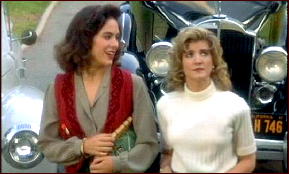
This is the kind of job that Dol and Sylvia Raffray, her partner in PI work, are equipped to do. They’re not ready for the big leagues, though, as they quickly discover when their client is found hanged from a tree behind his mansion. The killer used gloves to protect his hands; hence the title of the novel.
The color photography is quite terrific, reproducing the period in wonderful detail – the clothing, the hairdos, the newspapers, the automobiles – all extremely well done. But there’s no spark to the tale. It may be that there are too many characters, and it takes a lot of time for the viewer to know who each of them are, and their relationships to each other. All of these characters seem to have known each other for a long time before the story begins. It takes the viewer a while to catch up.
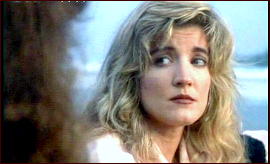
To be honest, and I’m sure you realize this, I’m talking about me. But I don’t believe the movie did all that well in the ratings, and assuming that it was intended to be a pilot for a possible series, it didn’t work, no matter how much money was spent on production.
There’s no spark to the story, as I said before. I’ll lay some of the blame on the actors also. When you watch a movie and you see actors playing their roles, instead of being their roles, then you know that something is just not working.
« Previous Page — Next Page »

